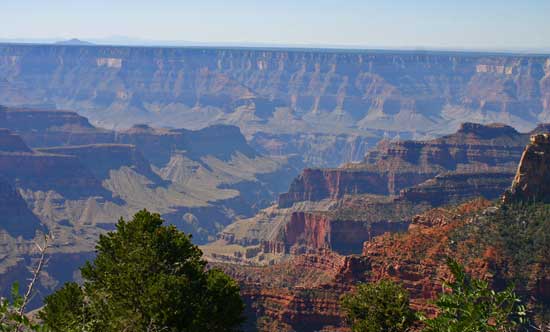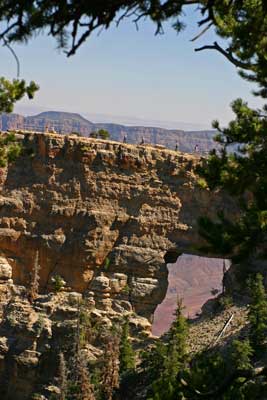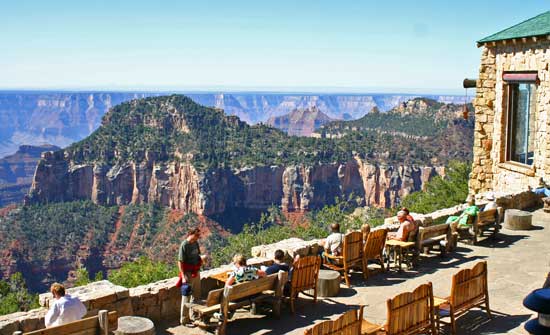

One of America’s most iconic sights has to be the Grand Canyon. But a visitor’s experience there may well depend on which Grand Canyon they choose.
You see, the Grand Canyon has a split personality.
The South Rim bustles with activity, with visitors vying for parking spots, rooms at lodges, tables in restaurants and even a place in line at the gift shop check-out. There’s an energy here generated by the multitude of visitors – about 4.5 million each year – all jockeying for their own best view and experience.
There’s a town, Tusayan, just outside the park, with still more lodging and dining options. The South Rim’s accessible most of the year. Even when it snows, it’s open, offering a varied experience each season.
Then there’s the North Rim.
It’s roughly 10 miles from rim to rim – as the condor flies. But it’s about 220 miles by car. And a world apart in many other ways.

The closest town on the north is Jacob Lake, Ariz., 43 miles away; it’s not exactly a tourist trap. The North Rim is only open a few months each year, from mid-May till mid-October, with limited access and services available well into November, depending on the weather. A significant snow closes the road for the season.
The Grand Canyon Lodge on the North Rim has no guest rooms; guests stay in one of 214 cabins or motel units, so the number of visitors on a given day is limited. This rim gets about 320,000 visitors annually.
The pace is more laid back here. This is the calmer, slower, more thoughtful Grand Canyon experience. It’s the kind of place where you park at a scenic pull-out and yours is the only car there, where you hike a rim trail and the only other living creature is a browsing mule deer or a curious blue jay.
“This is the place people come when they want peace and solitude,” says Maureen Oltrogge, a National Park Service public affairs officer who has worked in the park for 27 years and knows it well. “This is the quiet side.”
Our visit was a side trip between two other destinations and we had just about 24 hours to spend, but were determined to finally see the North Rim after half a dozen visits to its sister rim.
We arrived on a sunny autumn morning, driving the Kaibab Plateau-North Rim Parkway from the Jacob Lake turnoff past pastures and forests, sans neon lights and gaudy billboards, till we reached the North Rim entrance. We checked in at the old Grand Canyon Lodge, a National Historic Landmark built from native stone and overlooking the canyon. Actual rooms are a brief walk along a path from the historic lodge.
The spacious, rustic dining room was closed for lunch. Having foolishly neglected to make dining reservations in advance, we were relegated to eating both lunch and dinner in the Deli in the Pines– a cafeteria – filling, but unremarkable. We bought sandwiches and drinks to go, then went back to the lodge and made reservations for the next morning’s breakfast.
There are no shuttles – and mostly no need for them – on the North Rim. You can explore on your own, at your own pace, the same way you got here – by car, bike or on foot. Unlike the South Rim, which has so many visitors it can be hard to find a parking space during high season, there’s usually room here.
On the South Rim, the canyon walls are so sheer, you rarely glimpse the Colorado River at the bottom. Though the North Rim is 1,000 feet higher, it’s more eroded and its sloping walls allow great views of the rock formations and the green-hued river below. (Due to ongoing drought conditions in the West, the river was looking a little muddy as it exited the canyon.)
We set out on our driving tour, starting with Point Imperial, 11 miles from the lodge and, at 8,800 feet in elevation, the highest point on the North Rim. From here, we could see the panorama of Mount Hayden, Saddle Mountain, Marble Canyon and the eastern end of the Grand Canyon, where it flattens out like a receding tide into the Painted Desert beyond. After our picnic lunch and the proper amount of ooh-ing and aah-ing, we drove another 14 miles to Cape Royal, which juts out over the canyon. Be sure to take the self-guided trail that leads to Angels Window Overlook.
On any hike here, watch your step. You’ll be so distracted gawking at the views, you might forget where you’re stepping. And you get fairly close to the open rim in some spots.
We stopped at one point to examine an object in the sky – well, I say the sky, but it was almost level with us. After all, we were more than a mile above the river at this point. At first, we thought it was a small plane or glider. Binoculars revealed it was a California condor. The giant prehistoric-looking birds have been successfully reintroduced into the canyon and one of them was soaring on the updrafts, perhaps seeking an afternoon snack. Or maybe he was just taking in the dizzying views.
A few hundred photos later, we headed back to the car, scaring up a jackrabbit or two along the way.
It was getting late in the day, so we opted not to take the strenuous 9-mile hike down the North Kaibab Trail to Roaring Springs, but saw several ambitious and well-equipped backpackers heading that way, planning to spend the night.
Next, we stopped at the Walhalla Glades to admire the tenacity of the ancient people who once lived here. The footprints of some of their dwellings can still be traced. Kaibab squirrels – a local subspecies of the tassel-eared Abert squirrel – rooted among the ground litter, looking for seeds.

Back at the lodge, we had time to stop by the visitor’s center. It’s small, with a few displays, and remarkably few souvenirs. It’s mostly a book shop, and we delighted in browsing for a while, identifying some of the things we had seen that day.
Having been advised not to miss sunset as seen from the Bright Angel Point (a half-mile hike from the lodge), we ended our leisurely afternoon back at the cafeteria (pizza this time), then took the easy but frighteningly narrow path out to the point. This was the first “crowd” we’d encountered. There must have been at least 20 of us huddled on the point, donning jackets as the sun began its descent and the air turned crisp.
As the sun melted into the rim, the light became increasingly beautiful and everyone politely gave way so others could get shots of the red-gold glow bathing the rocky walls.
We hiked back to the lodge before it got too dark and then sought our beds. The next morning, we headed to the lodge’s dining room – finally. After a hearty breakfast (yummy cranberry-walnut pancakes), we reluctantly left the park.
Driving out, we passed wild turkeys on the edge of the woods. They gave us little notice till we slowed for a better look, then panicked and flew along the ground to escape. They’re remarkably fast.
Another time, we thought, we’ll return and explore more trails. And next time, we’ll make reservations for dinner far in advance.
Travel to the Grand Canyon
Getting there: By air, the best options are to fly into Las Vegas, Nev., or Cedar City, Utah, and rent a car. Or you can fly into the Tuscan, Ariz., airport on the South Rim and take the Trans Canyon Shuttle to the North Rim (about five hours’ drive).
If driving: From U.S. Highway 89 at Jacob Lake, Ariz., head south on Arizona Highway 67 to the North Rim entrance.
Entrance fee: Unless you have an annual National Parks Pass or seniors pass, regular admission is $25 per vehicle, good for 7 days. Admission for individuals on foot or bicycle is $12. Admission is good for both rims.
Visitor Center: Hours are 8 a.m.-6 p.m. daily (but may be cut back a bit due to funding issues). Rangers are on duty to assist visitors and answer questions. Look for postings of ranger walks and talks, and a Junior Ranger program is based here.
Reservations: For camping, call 877-444-6777. Campsites cost $6-18. Reservations are a must and fill up early. Forever Resorts manages the Grand Canyon Lodge. Visit them at www.grandcanyonforever.com or call the toll free reservation line: (877) 386-4383. Prices range from $124 to $205 per night. For more details, go online to www.nps.gov/grca/planyourvisit.
Activities: If you want to arrange a trail ride in advance of your visit, contact on Grand Canyon Trail Rides at (435) 679-8665 or visit their website at www.canyonrides.com.
General information: Call 928-638-7888. After May 15, the North Rim informational brochure will be available online at www.nps.gov/grca/parknews/upload/2009TripPlanner.pdf.

Tips for Visiting the North Rim
Remember, the North Rim is relatively remote, so:
— Bring an extra set of car keys; it could be a long wait for a locksmith.
— Some film, memory cards and commonly used batteries are available at the North Rim, but the closest camera repair is a day’s drive away.
— There is no automobile mechanic on the North Rim.
— Carry water in your car, particularly during summer months. Bring your own water bottle – individual bottled water is no longer sold in the park. There are lots of places to fill your own bottle.
— Keep your gas tank full. The next gas station may be quite a few miles distant. There is a gas station near the campground that also offers diesel fuel.
Grand Canyon FAQ
Size: The Grand Canyon is more than a mile deep in some places, and 275 miles long. The park encompasses more than 1.2 million acres and is 10 miles wide, rim to rim, at many points.
History: The Colorado River is credited with carving the canyon over the past several million years. It’s considered one of the seven natural wonders of the world. It is believed the Desert Archaic people (related the ancestral Puebloans, or Anasazi) lived there as long as 4,000 years ago. In 1776, the Dominguez-Escalante expedition recorded its wonders in journals, as did John Wesley Powell, who first explored it via the Colorado River in 1869. It became a national monument in 1908 and was established as a national park in 1919. The original Grand Canyon Lodge was built in the 1920s, burned down in the 1930s, and was rebuilt.
Geology: Somewhere between 6 and 10 million years ago, the Colorado River cut a mile-deep swath through the Colorado Plateau to create the canyon, in a long, complicated process you can read about in guidebooks or park displays. Essentially, this process revealed layer after layer of different kinds of rock, including sandstone, granite, shale, limestone and lava. The variegated colors of the canyon walls reflect these layers in red, brown, cream, gray, pink and white. It makes for dramatic photos, especially at sunrise and sunset, when light floods the canyon from the end.
- Life of a Champion: Exploring the Muhammad Ali Center in Louisville - April 19, 2024
- What It’s Like to Live as an Expat: Lake Chapala, Mexico - April 18, 2024
- Top 5 Spots for Stargazing in North Carolina - April 17, 2024

Want to explore the Gloria of the Grand Canyon? Try this one
http://www.tripedition.com/West-Coast/Las-Vegas/3-Day-Grand-Canyon-South-Rim-and-Las-Vegas-Bus-Tour-from-Las-Vegas-html